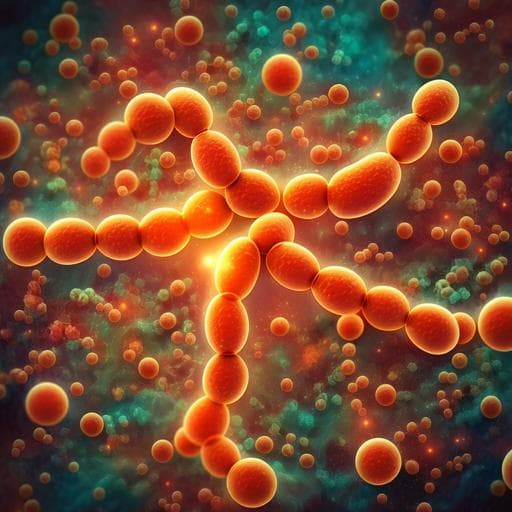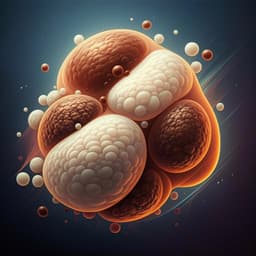
Food Science and Technology
Complete and efficient conversion of plant cell wall hemicellulose into high-value bioproducts by engineered yeast
L. Sun, J. W. Lee, et al.
In a groundbreaking study by Liang Sun and colleagues, researchers uncovered how acetate—a known fermentation inhibitor—can be co-consumed with xylose by engineered *Saccharomyces cerevisiae*. This innovative approach transforms a disruptor into a usable substrate, significantly enhancing the synthesis of valuable bioproducts like triacetic acid lactone and vitamin A from lignocellulosic biomass.
~3 min • Beginner • English
Introduction
The study addresses a central challenge in lignocellulosic biorefineries: acetate released from acetylated hemicellulose and lignin accumulates in plant cell wall hydrolysates and inhibits microbial fermentation. While S. cerevisiae is robust for industrial production, glucose repression and acetate toxicity hinder acetate utilization and acetyl-CoA-derived product formation. The authors hypothesize that, unlike glucose, xylose metabolism under aerobic conditions does not repress acetate transport/metabolism and can support rapid co-consumption of xylose and acetate. This could detoxify acetate and expand cytosolic acetyl-CoA supply to enable efficient production of acetyl-CoA-derived bioproducts (e.g., TAL, vitamin A) directly from hemicellulose fractions.
Literature Review
Prior work has focused on reducing acetate formation via plant cell wall engineering or optimizing biomass pretreatment, and on pre-fermentation detoxification methods (physical/chemical/biological), each with added costs. Engineering acetate tolerance in yeast alleviates but does not remove inhibitory effects. An NADH-dependent acetate reduction pathway coupled to xylose assimilation improved ethanol production anaerobically, but is limited by enzyme activities, ATP/NADH availability, and is product-specific to ethanol. Although oleaginous yeasts readily convert acetate to acetyl-CoA and downstream products, S. cerevisiae’s acetate utilization is slow and toxic under typical fermentation, with glucose strongly inhibiting acetate transport and metabolism. S. cerevisiae can grow on acetate aerobically at neutral pH via transporters (Jen1, Ady2) and conversion by acetyl-CoA synthetases (Acs1/2), feeding the TCA/glyoxylate shunt, but respiration on acetate alone has drawbacks (ROS, ATP imbalance). These gaps motivate coupling xylose metabolism with acetate assimilation to valorize acetate and boost acetyl-CoA supply in S. cerevisiae.
Methodology
Strain engineering: A xylose-fermenting S. cerevisiae background (SR8 derived from SR7) was used to study xylose–acetate interactions. For TAL production, a codon-optimized Gerbera hybrida 2-pyrone synthase (2PS; UniProt P48391.2) was synthesized and cloned into pRS426 under the CCW12 promoter/CYC1 terminator; integrative versions were constructed in pRS403/404/405/406 to vary copy number. A TRP1 deletion was introduced by CRISPR-Cas9 in strain CT2-auxo to enable auxotrophic selection, yielding CT2-4. Linearized integrative plasmids were sequentially transformed to generate Tal1–Tal4 strains (1–4 copies of 2PS). An isoprenoid pathway strain (SR8A) was used for (pro-)vitamin A production (heterologous CrtE, CrtYB, CrtI, BCMO per prior work).
Culture conditions: Shake flasks used modified Verduyn medium (30 °C, 300 rpm) buffered at pH 5.50 with 50 mM potassium hydrogen phthalate. Carbon sources included glucose, xylose, acetate (as potassium acetate), or ethanol. Inocula were from YPD. Initial OD600 was 1 for defined medium and unconcentrated hydrolysate TAL experiments; OD600 10 for other flasks.
Bioreactor: Fed-batch in a 3-L bioreactor (1 L working volume) at 30 °C; initial OD600 4.0. Medium: Verduyn with 40 g/L xylose + 10 g/L acetate; additional xylose and acetate were fed to restore initial concentrations upon depletion. Aeration/agitation adjusted (3–5 Lpm) to maintain aerobic conditions. pH controlled at 5.5 with 4 M NaOH/HCl; antifoam added as needed.
Switchgrass hydrolysate preparation: Switchgrass (10% solids) underwent dilute-acid hydrolysis (2% H2SO4) at 121 °C for 60 min; liquid fraction was separated and neutralized with Ca(OH)2 to pH 5.5. Two-fold concentration produced hydrolysate containing (g/L): xylose 40.00, acetate 6.26, glucose 6.31, furfural 2.01, HMF 0.42. Tal4 was cultured in 50 mL hydrolysate (with 2 g/L yeast extract and 2 g/L peptone) at 30 °C, 300 rpm (initial OD600 ~10 for 2× hydrolysate; 1 for unconcentrated).
RNA-seq: SR7 was cultured in YP with 40 g/L glucose or xylose (30 °C, 100 rpm). Cells were harvested at OD600 ~1; total RNA extracted (YeaStar RNA Kit). Libraries sequenced (Illumina HiSeq 2000). Reads mapped to S288C; RPKM compared (xylose vs glucose) across triplicates; statistics via two-tailed t-tests.
Analytics: OD600 measured and converted to dry cell weight (DCW) using 0.41 g DCW/L per OD unit. HPLC quantified glucose, xylose, xylitol, acetate, glycerol, ethanol (Rezex ROA H+ 8%, 0.005 M H2SO4, 50 °C, 0.6 mL/min, RI detector). Lipids quantified by chloroform/methanol extraction and gravimetry. Ergosterol quantified by saponification, n-heptane extraction, HPLC-UV at 280 nm (C18 column, 100% acetonitrile, 2 mL/min). TAL quantified by HPLC-UV at 280 nm (C18, 40 °C), mobile phases: A 1% acetic acid in water (90%), B 1% acetic acid in acetonitrile (10%), 1 mL/min; addressed TAL precipitation by serial dilutions. Beta-carotene and vitamin A quantified by HPLC-UV (453 nm and 352 nm) with 95% methanol/5% acetonitrile mobile phase. Statistical analyses used one-way ANOVA with Tukey’s post hoc test as appropriate.
Key Findings
- Xylose enables efficient aerobic co-consumption of acetate: In glucose cultures (40 g/L), acetate was not consumed and inhibited growth and ethanol re-assimilation. In contrast, in xylose cultures, up to 15 g/L acetate was assimilated, and xylose consumption was slightly enhanced by acetate (up to ~12.38 g/L co-assimilated at ~0.23 g/L/h).
- Mechanisms: RNA-seq showed higher expression on xylose vs glucose of ADY2 and JEN1 (acetate transporters) and ACS1 (acetyl-CoA synthase), while PMA1 (plasma membrane H+-ATPase) was lower. Ethanol (>4.25 g/L) impeded acetate consumption; this repression is avoided in xylose cultures due to inactive overflow metabolism. Glucose consumption lowered medium pH to <4.6, increasing acetate toxicity; co-consumption of xylose and acetate increased final medium pH.
- Enhanced acetyl-CoA availability: Co-consumption increased biomass and intracellular acetyl-CoA-derived components. With 40 g/L xylose + 12 g/L acetate, lipids reached 71.93 ± 2.07 mg/g DCW (≈48% higher than xylose alone: 48.64 ± 4.70 mg/g DCW), and ergosterol reached 26.90 ± 1.31 mg/g DCW (≈45% higher).
- Establishment of TAL production: Expressing 2PS enabled TAL production. From xylose, Tall produced 198.46 mg/L vs 33.24 mg/L from glucose (~6×). Increasing 2PS copies to four (Tal4) raised titers to 1,522.44 mg/L (xylose) and 539.87 mg/L (glucose). As single substrates, TAL yields (mg/g substrate) ranked: acetate 107.81 > xylose 47.47 > ethanol 40.51.
- Synergy with mixed substrates: With 40 g/L xylose + 10 g/L acetate, Tal4 produced 4,936.77 mg/L TAL at 90.24 mg/g overall yield, roughly 3× titer and 2× yield over xylose alone. Best performance occurred around a 4:1 xylose:acetate ratio, typical of hemicellulose hydrolysates.
- Bioreactor performance: Fed-batch co-feeding of xylose and acetate achieved 23.89 g/L TAL with volumetric productivity 0.29 g/L/h. TAL exceeded its solubility (8.6 g/L), with precipitation observed; glycerol (2.79 g/L) was the only byproduct at the end. Cell growth slowed after ~56 h when TAL reached ~9.51 g/L, consistent with TAL toxicity.
- Hemicellulose hydrolysate conversion: In 2× concentrated switchgrass hemicellulose hydrolysate (xylose 40.00 g/L, acetate 6.26 g/L, glucose 6.31 g/L, inhibitors present), Tal4 completely consumed sugars and acetate within 115 h and produced 3,545.74 mg/L TAL at 67.45 mg/g yield; glycerol accumulated to 4.92 g/L (likely osmotic stress). In unconcentrated hydrolysate, no glycerol accumulation was observed and overall yield improved to 86.53 mg/g.
- Vitamin A pathway: Co-utilization of xylose and acetate also enhanced (pro-)vitamin A production in SR8A compared with xylose alone, demonstrating generalizability to other acetyl-CoA-derived products.
Discussion
The work demonstrates that engineered S. cerevisiae can efficiently co-consume xylose and acetate under aerobic conditions, bypassing glucose- and ethanol-mediated repression of acetate transport/metabolism. Xylose metabolism supports ATP and reducing power, enabling acetate assimilation directly to acetyl-CoA, while acetate consumption elevates medium pH and avoids the drawbacks of acetate-only respiration. This metabolic division of labor boosts cytosolic acetyl-CoA supply, as evidenced by increased lipids and ergosterol, and translates into substantially higher titers and yields of acetyl-CoA-derived products. TAL production reached 23.89 g/L at 0.29 g/L/h in fed-batch—exceeding prior S. cerevisiae reports and surpassing productivity achieved in Yarrowia lipolytica—while enabling complete conversion of real hemicellulose hydrolysates into TAL. Improved (pro-)vitamin A production confirms the strategy’s versatility. The findings transform acetate from an inhibitor into a co-substrate that expands the acetyl-CoA pool, directly addressing a key bottleneck in S. cerevisiae bioproduction and integrating seamlessly with lignocellulosic biorefineries. The approach suggests broader applicability of mixed carbon substrates (sugar + organic acid) to balance carbon flux, ATP, and redox for enhanced biosynthesis.
Conclusion
This study establishes a co-substrate strategy in engineered S. cerevisiae whereby xylose enables rapid aerobic co-consumption of acetate, overcoming glucose repression and acetate toxicity, and markedly expanding acetyl-CoA supply. The approach yields record TAL titers and productivity and achieves complete conversion of switchgrass hemicellulose hydrolysate to acetyl-CoA-derived products, while also improving (pro-)vitamin A production. The concept can generalize to other acetyl-CoA-derived chemicals and potentially other sugar–organic acid pairs (e.g., lactose–lactate, citrate with xylose), offering a paradigm for bioconversion that surpasses limitations of single-substrate fermentations. Future work could optimize transporter/enzyme expression, feeding ratios/patterns, and mitigation of product toxicity/solubility to further improve titers, rates, and yields, and explore additional product pathways and substrate combinations.
Limitations
- Glucose strongly represses acetate transport and metabolism; acetate was not consumed in glucose cultures and inhibited growth and ethanol re-assimilation.
- Ethanol concentrations above ~4.25 g/L impeded acetate consumption, necessitating conditions that avoid overflow metabolism (e.g., xylose-based, aerobic).
- Medium acidification during glucose consumption (pH <4.6) increases acetate toxicity; careful pH control is required.
- TAL exhibited toxicity at high concentrations; cell growth slowed when TAL reached ~9.5 g/L, and TAL precipitation above its solubility (8.6 g/L) complicates handling and may affect productivity.
- Concentrated hydrolysate led to glycerol accumulation (likely osmotic stress), which can reduce carbon efficiency.
- The demonstrated strategy relies on aerobic cultivation and engineered xylose metabolism; performance under different oxygen transfer or substrate conditions may vary and requires further optimization.
Related Publications
Explore these studies to deepen your understanding of the subject.







